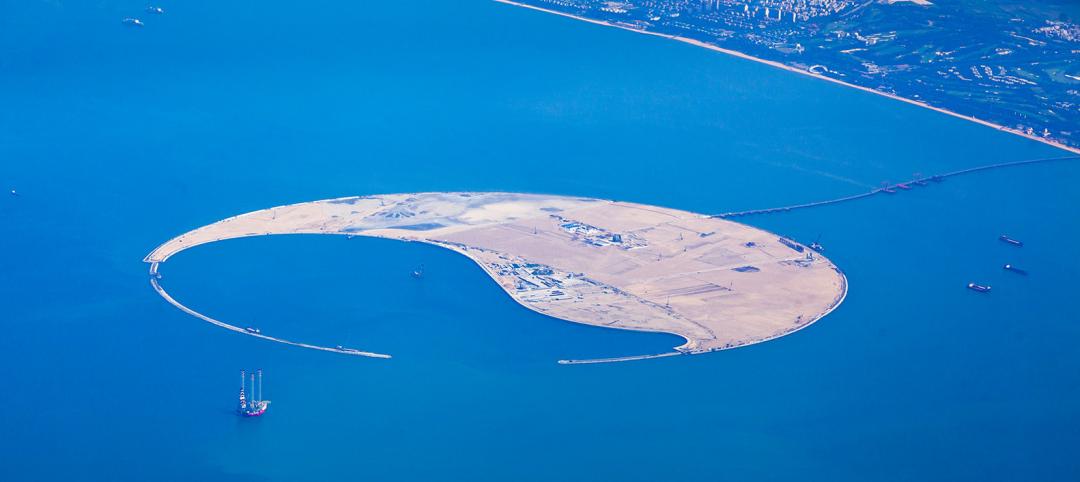From pearlescent and iridescent coatings to highly accurate color-matching tools to programmable, color-changing LED lights, color is taking on a bigger and increasingly high-tech role on building projects.
The widespread growth of colorized materials—from metal wall and roof panels to glass and glazing systems, to metal mesh assemblies—and the availability of custom colors across a broad range of product lines have provided architects and designers with almost limitless options for exterior and interior design projects.
Technology tools like 3D modeling software and color-matching apps have taken much of the guesswork out of evaluating colors and color palettes for building design projects. And advances in manufacturing—from new textile printing methods to novel coating formulations—are leading to breakthroughs in hues, patterns, textures, and special effects in colorized materials and finishes.
Given the “color craze” in architecture, it is no surprise that most design professionals believe that color plays a more-critical role in today’s building design projects than those from a decade ago.
Findings from BD+C's 2020 Color Trends Report
Two-thirds of architects, interior designers, and color experts surveyed between December 2019 and March 2020 by Building Design+Construction for the 2020 Color Trends Survey said that color on design projects (interior spaces and exterior design) is more important today than it was a decade ago. And fewer than 2% believe color is less important.
The growth in demand for color in the commercial, institutional, and multifamily building sectors is being driven by several converging trends. For one, clients are more willing to accept risk and variation on their projects, according to survey respondents.
“Especially for interiors, the story told by a color palette is crucial to creating an experience that can be differentiated from the norm,” said one architect respondent.
The rising cost of materials and construction is another important consideration: “Color is one of the easiest ways to add impact for the least amount of cost, thus more important today with the rising costs of everything.”
The final PDF report of BD+C's 2020 Color Trends Survey includes data on:
- Innovations in color and colorized materials
- Specification trends in color and colorized materials
- Source of color expertise and inspiration in design firms
- The importance of color on today's building projects (interior and exterior applications)
- The importance of color in 2020 vs. 2010
- Reasons for the change in the importance of color on building projects
- Use of special effect coatings
- Biggest innovations in color related to interior or exterior building design
Download the 2020 Color Trends Survey report (short registration required)
Special thanks to Sherwin-Williams Coil Coatings
for their support of this BD+C editorial research project.
More at coil.sherwin.com.
Related Stories
Building Tech | Aug 26, 2016
NBBJ’s Goldilocks sensor technology can help employees find a workspace that is just right
The technology measures light levels, humidity and temperature, motion, and sound.
Great Solutions | Aug 23, 2016
11 great solutions for the commercial construction market
A roll-up emergency department, next-gen telemedicine center, and biophilic cooling pods are among the AEC industry’s clever ideas and novel innovations for 2016.
| Aug 19, 2016
RECONSTRUCTION GIANTS: Facelifts give buildings new identities, even as they keep a few wrinkles
Reconstruction is always a balancing act between the client’s pro forma and what the building needs to be vibrant again.
| Aug 19, 2016
Top 130 Reconstruction Architecture Firms
The Beck Group, Stantec, and IMC Consruction top Building Design+Construction’s annual ranking of the nation’s largest reconstruction sector architecture and A/E firms, as reported in the 2016 Giants 300 Report.
| Aug 18, 2016
LOCAL GOVERNMENT GIANTS: A ranking of the nation’s top design and construction firms in local sector work
HOK, Stantec, Turner Construction Co.,Clark Group, AECOM and STV top Building Design+Construction’s annual rankings of the nation’s largest local government sector AEC firms, as reported in the 2016 Giants 300 Report.
| Aug 18, 2016
STATE GOVERNMENT GIANTS: A ranking of the nation’s top design and construction firms in state sector work
CannonDesign, Stantec, Turner Construction Co.,Mortensen Construction, WSP | Parsons Brinckerhoff and AECOM top Building Design+Construction’s annual rankings of the nation’s largest state government sector AEC firms, as reported in the 2016 Giants 300 Report.
Hotel Facilities | Aug 17, 2016
First of its kind tri-branded Marriott hotel under construction in downtown Nashville
The hotel will combine the AC Hotels, Residence Inn, and SpringHill Suites brands.
University Buildings | Aug 16, 2016
New images of Rice University’s Moody Center for the Arts revealed by Michael Maltzan Architecture
The arts center will foster creativity for making and presenting works across all disciplines
Designers | Aug 16, 2016
CCDI, Morphosis, and Diller Scofidio + Renfro are among ten finalists vying for Chinese Eco-Island design
The winning firm will design the master plan and central buildings for the man made Haikou Bay island.
Mixed-Use | Aug 16, 2016
Goettsch Partners completes mixed-use tower in R&F Yingkai Square
The 66-story building is now the 7th tallest completed building in Guangzhou.


















